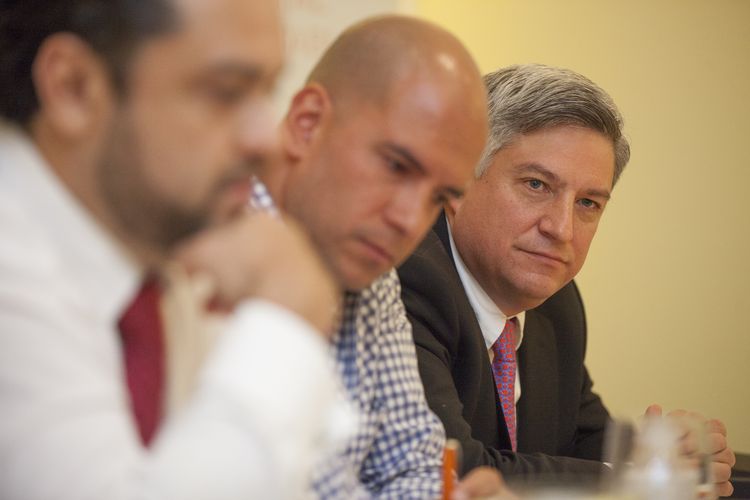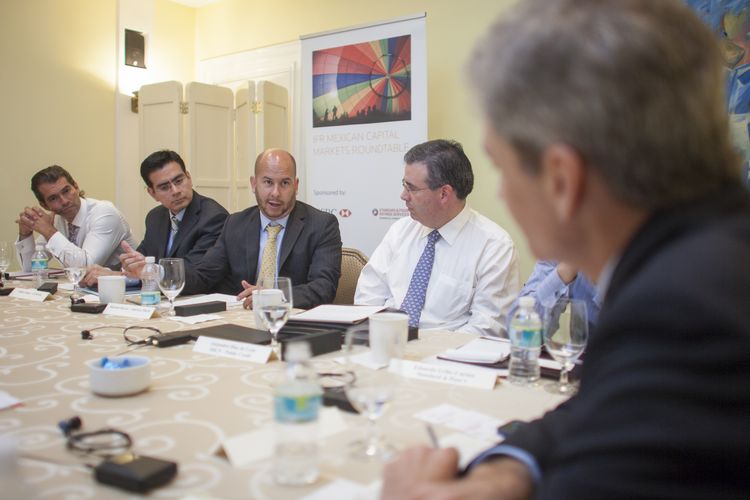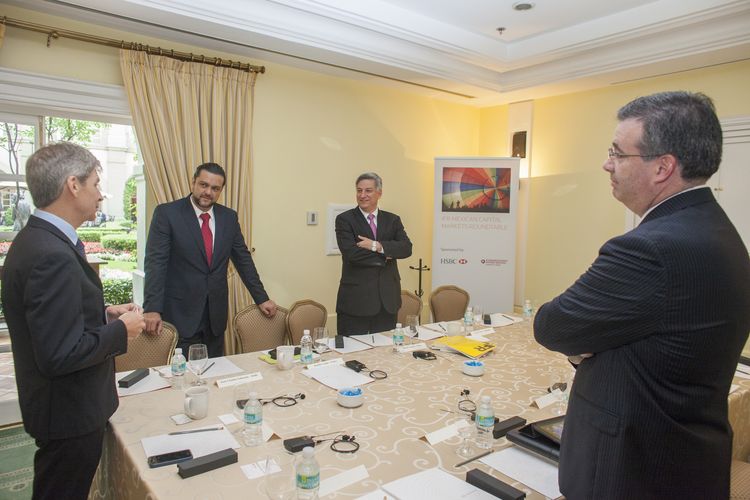To see the digital version of this report, please click here.
To purchase printed copies or a PDF of this report, please email gloria.balbastro@thomsonreuters.com.
IFR: Just going back to how local pension funds have often dominated pricing dynamics for borrowers in Mexico. What is being done to encourage a change in their investment strategies?
Diaz de Leon, Ministry of Finance: AFORES were the sole driver of term premium, even in our government yield curve before foreigners stepped in.
When they were really bullish, you had a rally and the reverse [when they weren’t] so AFOREs tend to be highly correlated among themselves and how they view things. That is a phenomenon we are trying to address.
A recent change in regulations is forcing AFOREs to have benchmarks. They are going to define their own benchmarks and they will have to provide information to their investment and risk boards in terms of how they are beating those benchmarks. We want AFOREs to have a medium-term view.
It’s interesting because AFOREs are long-term investors, but they have relatively short-term incentives in how they manage their business. We need to provide different incentives so that they are better aligned and less dependent on short-term fluctuations.
They tend to be more pro-cyclical than other investors that have more liquidity constraints than they do. So at the end of the day, they could play a role in terms of having a view and a portfolio that does not have to move in a pro-cyclical way.
Julian Gomez Faustino, CONSAR: I think that is very important because right now, as Alejandro said, prices of many financial instruments don’t reflect underlying fundamentals. So, AFOREs always have that problem in pricing the fund. I think that the kinds of mechanisms that Alejandro was talking about can help to set a real price on financial instruments.
In general, there are portfolio restrictions but they are not limiting AFORES. They have enough space to increase their investments.
Rivera, America Movil: Next year is going to mark the twentieth anniversary of the creation of the AFOREs. We are trying to compare our market to our closest neighbour, the United States, which has had this type of market for over 100 years.
Growth, not only in AFOREs but also in investment firms, has enormous potential. In the US you have a lot of very large corporations and a lot of very large pension funds and institutional investors that are able to participate on both sides.
Right now we have a few pension funds and a few large corporates. It’s about building critical mass as time goes on and I think that regulation is trying to catch up with some of the lags that have been generated in the past. But the depth the peso market has for issuance is nothing like anything else in Latin America, not even Chile.
Chile has had a very sound financial market for a long time. [But] it is still confined to inflation-linked issuance on the long-end.
IFR: Mexico is still not a double A credit like Chile, but it did get put in the single A category for the first time this year when Moody’s upgraded it to A3. How has this changed the investor mix for the sovereign and potentially for corporates going forward?
Martinez-Ostos, Barclays: Ten years ago, bonds issued by UMS, America Movil or Pemex were just bought by emerging market investors and hedge funds.
If you look at the books now, they are bought by highly sophisticated investors and for the EM guys these are expensive deals that they don’t buy into. I was looking at the books on a UMS bond issued in 2009. Thirty five percent of that book was bought by hedge funds. On the recent 2044 issue, only 3% of the book was bought by hedge funds. That tells you a lot – so our job as bankers is also to work together with issuers and tailor make structures to cater for new investors.
Diaz de Leon, Ministry of Finance: We just recently made a transaction in yen [Mexico’s first 20-year ever in the Samurai market], and there has been an inflection point in the type of demand and the type of tenors that this investor community is willing to buy.
IFR: How has the composition of the government peso bond market changed? What are the advantages and disadvantages of having so many foreign investors involved in your local curve?
Diaz de Leon, Ministry of Finance: In recent years we have seen a major recomposition in terms of who is buying what and I think a very large part of that is structural.
It’s not only because of the cycle of low interest rates, and the move towards EM securities. I agree that we have been successful in attracting foreigners to our Mbono (fixed-rate Treasury) yield curve. We are starting to do that also on the [inflation-linked] UDIbono yield curve.
For us it has been tremendously beneficial to have a disciplinary mechanism in the pricing, and having foreigners involved in our market.
There is always a question of whether foreign involvement makes the market riskier or less risky. There isn’t a “yes or no” answer to that question. It entails tremendous benefits and we have clearly enjoyed them in terms of lower yields, extension of duration and a better diversified pool of investors and so on.
We saw last year, that even in a particularly stressed scenario – associated with interest rates in the US – foreigners were not rushing out of the Mbono market. Holdings of Mbonos were tremendously resilient, in part because investors can hedge those risks very quickly and not necessarily sell their positions.
Of course in really adverse scenarios foreign investors may play a destabilising role, but for that we have sufficient firepower in international reserves, the IMF’s flexible credit line and so on. So we are prepared for a potentially bad scenario.
On the whole, I think foreign participation has resulted in an improvement in terms of financing. Our challenge is to make this available for corporates, which still do not enjoy the same advantages as the sovereign – at least directly. Indirectly they do, because if the government yields drop, every debtor in the economy, even households, even credit cards, benefit.
But that’s not enough. We need to get foreigners involved in a more direct way [with corporate peso debt], both to enhance liquidity and to improve price dynamics.
IFR: What about access to local peso bond funding for junk credits? It seems to me that this market still remains the domain of blue-chip corporates.
Albarracin, Milbank: It’s about regulatory constraints mainly on local institutional investors like pension funds, and minimum rating requirements.
Calvo, Santander: You still face the liquidity issue [in high-yield instruments]. You could be a proud owner for 10 years of these bonds and the day that company goes into distress, you don’t have any outlet.
So it’s a matter of having more investors at the table. Why do they even buy equity which is lower in the security chain? Because they can get in and out of the stock. It’s not the same with a bond.
Martinez-Ostos, Barclays: I hear your point, but I don’t necessarily agree in the sense that you also can’t sell stocks of many of these issues in a stressed scenario.
We understand the system has to mature and evolve. There are certain rating thresholds for peso-denominated securities. And the reality is that many of the pension funds continue to – when it comes to fixed income paper – to gravitate to four or five [investment-grade] names.
Many times people tend to use the regulatory side as an excuse to not participate and regulations are out there [to allow AFORES to invest more freely] but they have not made use of that opportunity.
Calvo, Santander: Following the same thought, I think about the resources that the AFOREs have for analysing risk.
At the moment, many of them are focused more on government securities. They are ex-traders or people who have not analysed corporate risk for a long-time.
Maybe they are just beginning to start, but given the situation, they just prefer the large deals that have liquidity instead of looking for the yield in a US$200m dollar peso deal.
It’s been easier to buy these big deals than analysing all the little details that could make them much more profitable.
Diaz de Leon, Ministry of Finance: I would add that our pension system, with its virtues, is a closed system. It’s not an open system like in Sweden and it is a compulsory system for compulsory savings. This reduces market discipline. You don’t provide a good return by switching from name A to name B. The authorities for many years have tried to increase these incentives to provide better returns, sometimes successfully, sometimes less successfully.
Sometimes AFOREs see themselves more as a commercial business and focus on the number of affiliated workers they have. Probably they spend more on the commercial area than on the financial area and this has been the nature of the business.
Recent social security reforms, which have already been approved by the lower house, are trying to correlate commissions with the performance, and that has been the overall idea in recent years – how to increase that.
I was on the buyside, for several years, and you tend also to focus on instruments in which you have more skin in the game.
When you have a large position in government securities, you are going to devote a lot of effort to that. If you have a relatively small position in credits, you will devote less attention to that. So at the end of the day the returns AFORES achieve are explained more by movements in our UMS yield curve than by any other factor.
As our yield curve becomes more stable, more predictable, AFORES will not be able make a lot of money out of investing in government securities and they will need to move elsewhere. This will mean that they will have to develop their expertise in stock-picking, credit analysis and investment in infrastructure securities.
We are still bringing new products to the market and developing a broader credit spectrum, which I agree with you, is not there. For the large, well-known companies, there are a lot of options, but less so for the rest. And even though regulations allow AFOREs to play in those buckets, I think for them the risk-reward has not been worth the effort.
It will be harder to make money from a stable government yield curve. And this will force AFORES to put some resources to work in credit.
I do see that the stage is set for some of these things to change. Hopefully we will do that and hopefully if we have these Euroclearable Cebures, I think that will also contribute in a significant way.
Campos, Pemex: Even for a company as big as Pemex, that is going to be an important challenge for the future. Just to put it into context, the capex of Pemex is huge. If you add the capex of all the companies listed on the Mexican stock exchange, it accounts for 70% of our capex, which is about US$27.7bn this year.
We had been using the balance sheet of the banks to finance our platforms for example. Right now we have a portfolio of projects for about US$20bn for things like floating refineries called FPSOs, pipelines and cogeneration plants, as well as platforms and jack-ups.
But with the new regulations, banks are not going to be relevant players anymore. So we have to look to large institutional investors [to cover those funding needs].
We have visited sovereign wealth funds in the Middle East and their appetite for these kinds of projects is huge, but some of them have mentioned that they need the participation of AFOREs in order to co-invest.
They need local players doing the credit analysis so they feel more comfortable investing in the project. So that is why pushing AFOREs to participate in these kinds of projects is very important.
IFR: What are your plans to address the billions of dollars in unfunded pension liabilities at Pemex?
(Subsequent to the roundtable, the Mexican congress approved legislation to allow the government to assume a portion of the company’s pension liabilities)
Campos, Pemex: Obviously this is a big challenge. Let me explain why we are in this situation. The pension scheme that we have was the first one in Mexico.
Back in the 1940s the life expectancy at birth was around forty years old. This figure has been evolving positively. For women it’s now about 78, for men, 73 and obviously that has made these liabilities grow dramatically. Obviously the union has a very important role to play here, but they are sensitive about this.
They understand that something has to be done. Our attention has been focused on the secondary legislation and constitutional reform, but I would say that right after that process, we will be in a position to discuss this issue. That is a very important change that we should make. Right now pension liabilities account for about US$100bn and that is completely unfunded.
IFR: State of Rio’s public pension fund recently tapped the bond market to cover the fund’s actuarial deficits. I wondered if Pemex would contemplate something similar?
Campos, Pemex: Yes, but I don’t see that as a second step, because first of all we have to close the current pension population and then you can think about vehicles to hedge the longevity risks.
There are a lot of hedge funds that try to arbitrage your actuary models, and if they see a space, you can reduce this longevity risk.
But I don’t see that as a second step. The first one is just to do what the rest of the relevant players have been doing – the government and the private sector, including state utility CFE. So basically the only one left is us, so we should take that step and then we can analyse those other possibilities.
Albarracin, Milbank: It creates an opportunity for more players that specialise in management of pension assets to become involved and manage these liabilities more efficiently.
It also creates a new investor base. In Colombia for instance, right now the main investors in bonds and stocks in the local market and now even in the international markets, are often these pension liability companies. These were created, not as a substitute for AFOREs or AFPs, but to specialise in managing pension liabilities of former state-owned companies that needed to privatise the businesses and try and clean up their balance sheets. It’s been a great opportunity for fuelling additional liquidity in the market and providing expertise from the private sector.
IFR: Will we eventually see Pemex go public? What kind of company do you see Pemex becoming 10 years down the road?
Campos, Pemex: There are so many steps we should take before thinking about this. One obviously is what you just mentioned, cleaning up the balance sheet. With the negative equity, it’s almost impossible to think about an IPO or something like that.
There are many opportunities we should take advantage of first before thinking about going public, and there are no discussions [about privatisation or an IPO] as of today. [For now] we would like to be an important government player in the sector.
It is in the interest of the private sector to co-invest with Pemex, because obviously we are the ones that know the region. We think we will be a government entity for years and the most relevant player in the industry locally. Maybe in a decade from now there is a possibility to open up that discussion, but not yet.
Galindo, Pemex: We were talking earlier about the best way to spend our cash and allocate our investment resources. A good example of this
would be our refining business, which has been losing money for years. Unfortunately we’ve been lagging desperately in refining and the reforms actually provide an opportunity to ramp up that business.
How we take advantage of reforms and how we are able to allocate our resources and how we reflect these results in our financial statements is a long-term process, but that will be key to maintaining our existing investor base and attracting new ones.
Albarracin, Milbank: I agree segregating the policy-making function from the national oil company role has been the catalyst for the development of the oil and gas sector in other parts of Latin America.
That really was the catalyst for change for state-owned oil companies in countries like Colombia, Brazil and Peru. By taking the policy-making function away from the national oil company, you have market dynamics driving the growth in the sector. The national oil company competes with other players, but without necessarily having to transform itself into [a completely private entity].
Every country has its national oil company. It’s not wrong. There is a reason why that exists and it addresses sovereignty issues. It’s an insurance policy for basic economic growth and stability because they are usually the most significant players in the market. It makes sense what Mexico is doing.
To continue reading this roundtable, click the relevant section. Introduction - Participants - Part 1 - Part 2 - Part 3


